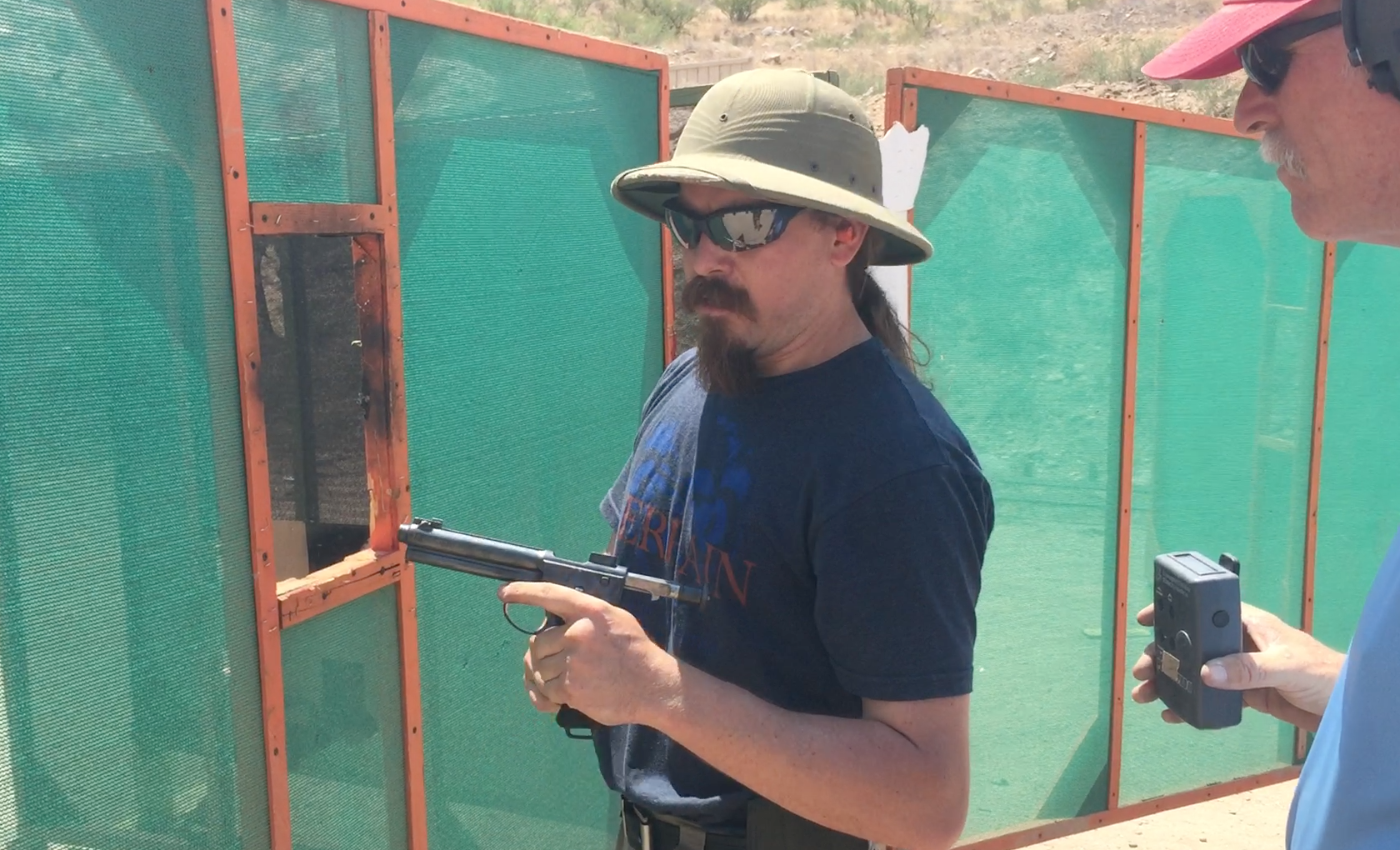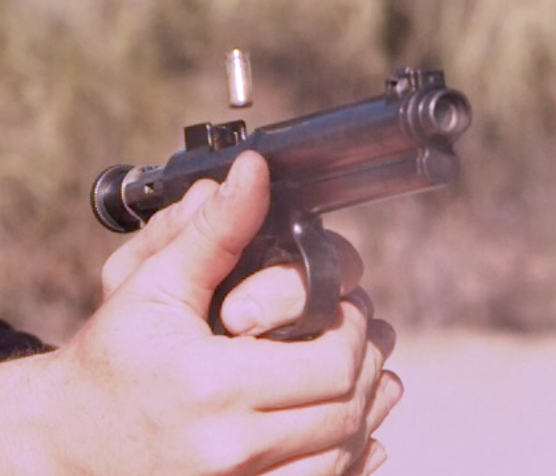After encountering Italian Villar Perosa machine pistols in the field, Austro-Hungarian troops requested a similar weapon. The project was given to FÉG to work on, and the result was the Pistolen-MG Model 1917: a pair of Frommer Stop pistols with long barrels and 25-round magazines, redesigned to fire from the open bolt, mounted to an adorably tiny tripod and spade grips.
Only a few dozen of these were made for testing, and they were not accepted for military service. Many thanks to Joschi Schuy for giving me access to film that fantastic surviving example for you!




This gun was patented by Frommer on the 27th of February 1917 (which probably means it had been in development since late 1916 at the least) and was, in fact, one of several attempts by the Austro-Hungarians to develop an equivalent weapon to the Villar Perosa.
The Austro-Hungarians actually conceived the machine pistol idea independently from the Italians. The first ideas were developed in the ranks of the Standschützen-Batallions, i.e. Tyrolean reservists who were stationed on the Italian Front. Two weapons of the machine pistol type appeared at the end of 1915 for Standschützen trials: the Maschinengewehr Hellriegel (which was likely derived from the earlier designs of Visini & Fuchs before the war), and the M.12/P16 machine pistol, which was designed at the request of Major Franz Xaver Fuchs of the Standschützen-Batallion Innsbruck II. Only a small number of these guns were made by February 1916 and were delivered to Major Fuchs’ battalion.
The Austro-Hungarians did not encounter the Villar Perosa in combat until the Battle of Asiago in May 1916, but they were immediately taken by the design. It was known by them at that time as the “Handmaschinengewehr” and by late 1916 a small number of trophy guns had been obtained. Upon the organization of the Austrian Sturmbataillons in early 1917, it was decided that a similar weapon should be adopted for assault use, as by this time both the Austrians and the Italians had realized the merits of the Villar Perosa as a trench-clearing weapon.
The three known guns that were trialed in March 1917 were:
* The ‘Doppelpistole’ M.12 by ŒWG in Steyr, constituting two Fuchs M.12/P16 machine pistols tethered together on a central buttstock;
* The Gépfegyver Frommer by FÉG in Budapest, i.e. the gun featured in this video, constituting two Frommer Stop pistols converted to full-auto and mounted on a tripod;
* The ‘Sturmpistole’ by Škoda in Plzeň, essentially a straight copy of the Villar Perosa, though chambered in 9x23mm Steyr and mounted to a flat wooden tray.
The Sturmpistole was clearly the best option and was selected for adoption in August. The k.u.k. Kriegsministerium ordered 50 guns for field trials. These were delivered to the front shortly before the Caporetto Offensive, where they were used in combat for the first time, but reportedly gave a poor performance. Further issues were ironed out and an improved iteration was adopted in 1918 (as the ‘Sturmpistole M.18’), with an order for 10,000 reportedly made; however by March 1918, only 85 had been delivered, and it is not known how many were made by the end of the war.
The Austrians made greater use of captured Villar Perosas than any domestically-made copies. Before Caporetto they had a few; after Caporetto they had 2,200. These were in such high demand that special ‘Maschinenpistole’ sections had been integrated into the Sturmbataillons by the middle of 1918, which were equipped with captured Villar Perosas, sometimes fitted to wooden buttstocks in an attempt to adapt them for shoulder fire. After the war, a former employee of the Škoda factory, Josef Netsch, designed a single-barreled copy of the Villar Perosa with a buttstock, which was trailed by the Czechoslovakian Army in 1919 but was not adopted.
“(…)Netsch(…)”
Interestingly this weapon did survive and is part of VHU PRAHA collection
http://www.vhu.cz/restaurovani-pokusneho-samopalu-josefa-netsche/
it was bought from descendant of designer in 1961.
Here is some more on these weapons w/ photos of the testing of the Frommer and the twin M.1912:
http://firearms.96.lt/pages/Steyr_M.12_P16.html
Actually the Austrians ended up straigh out copying the Villar Perosa with the Sturmpistole M.1918 in 9X23mm Steyr, so they rejected that specific gun, not the idea.
Any idea of the rate of fire? Villar Perosa’s ROF seems excessive for an infantry weapon, especially since it’s magazine-fed. Although apparently the Austrians still really liked the Villar Perosa.
The biggest problem I see with the FÉG’s weapon is the tripod system, which while light for a tripod (I assume), would still have been awkward for a single man to carry during assaults. Of course I don’t know what other problems it may have had. The weak cartridge certainly would not have helped either, nor the overly long single stack magazines.
I was able to find the RoF for the Sturmpistole in Get_Em_Puppy’s excellent database; 2400 rpm
http://firearms.96.lt/pages/Get_Em_Puppy's%20World%20SMGs.html
Getting shot through an infantry greatcoat by anything stronger than any .22 rim-fire is not fun. I imagine the tripod mount would have been concealed under foliage and the gun would act as an ambush weapon. Does anyone want to sprint past this while toting a 50-pound pack and a long rifle by his lonesome?
I wouldn’t like to be shot with anything, even .22 Short is quite lethal at close range…
A 9mm Parabellum round can still pass completely through a human body at 500m distance, and the 9mm Glisenti has at the muzzle more or less the speed that a 9mm Para has at 30m, so no real difference.
Today many people seem to like pointing out the deficiencies of the Villar Perosa (puny round, weird setup, too high ROF…) but, from 1915 to 1918, in trench warfare, it had been the ultimate stick of doom. It’s no wonder who happened to be on the wrong side of the barrels wanted to copy it. While who was on the right side didn’t think that much about improving it. Because there was nothing better to compare it anyway.
@Dogwalker
I just wonder how much the high RoF of the Villar Perosa has been seen as a proof that it must have been designed for aircraft use. We now know, and I hope Ian knows as well, that it’s just a myth and that the gun was intended for infantry from the beginning, but many people with poor sources must have thought it “proves” aircrafts were the design target.
I would also like to know if the standard was to fire both barrels simultaneously or a single barrel at the time. 1200 rpm would seem sufficient for any infantry tactical use, so the question arises why the weapon was double barreled, unless the SOP was to fire just one barrel and reload while the other barrel was fired. This was something Ian suggested in his Villar Perosa shooting video, but I didn’t see anyone commenting it here. YT’s comments section I didn’t bother to look at…
I agree that 9mm Glisenti was quite powerful enough for the weapon. Incidentally, do you know if 9mm Glisenti was supersonic from the long barrels of the Villar Perosa or did it stay subsonic?
@Dogwalker: The “right side” (by which I assume you mean the Italians) did do a lot to improve the Villar Perosa… first the Corpo Aeronautico Militare received the Carabinetta OVP, which was a single-barreled version with a detachable buttstock, though this was intended only as a PDW for aviators and was not distributed to infantry. By 1918 however, General Badoglio had (rather sensibly) decided that the Villar Perosa should be replaced by two new weapons: a light machine gun proper (the SIA Mod. 1918), and an automatic shoulder carbine (the Moschetto Automatico). Beretta were given instructions to convert 5,000 Villar Perosas into 10,000 ‘Moschetti Automatici Revelli-Beretta’, which were to be issued to ‘Musketeer’ troops attached to each battalion. However this order was never fully carried out before the war ended and only a small number of Revelli-Beretta carbines were actually delivered. It was an excellent idea but came just too late.
@Euroweasel: Villar Perosa gunners were trained to get about 3 or 4 bursts out of each mag before reloading, firing from one barrel at a time. Of course, in the stress of combat, this wasn’t always possible…
Certainly in the later part of the war, when the bipod mount was issued to replace the shield mount, firing both barrels at once would have been very unpleasant and barely controllable. The bipod did not offer much recoil support and accuracy no doubt suffered as a result.
@ Euroweasel
365 m/s are reported, so supersonic, but I don’t know if that’s with regular M910 cartridges or with the hotter M915, specifically destined to the OVP.
This gun (or guns, to be technical) reminds me, especially the tripod, of a gift I got my fifth birthday. A miniature M1919A4. Sure wish I hadn’t passed it on to my ypunger cousins when I grew older
Elbonian Military Weapon?
Only if it is issued to the anti-aircraft artillery.
I’d sure like to see the shoulder-stock equipped version that still used the thumb trigger! Much more practical, pragmatic. I’d think .380 or 9x17mm Court/corto/kurz would be a bit better, but then again, looks like the FEG company almost had the “skorpion” .32/7.65mm “machine pistol” all the way back in the first couple decades of the 20th century… Fascinating that this actually still exists and is not confined to a few parts or a photograph or two…
7.65×17mm Frommer Long (hot loaded .32 ACP) was the standard pistol caliber of the Hungarian part of the Austria-Hungarian Army, which is probably why it was chosen by FÉG for this contraption. I don’t know if they made the 9mm Frommer (hot loaded .380 ACP) version of the Frommer Stop during the war at all, but probably no, if I venture a guess.
In retrospective, to me, the 8mm Roth-Steyr would have been a great choice for the Frommer-Stop.
About the same diameter than the .32 ACP (even slightly shorter rim diameter), rimless, and with plenty more power (comparable with the 9mm Glisenti or, today, with the .30 Super Carry).